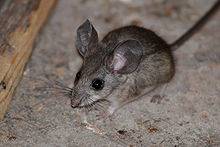Pinyon mouse
| Pinyon mouse | |
|---|---|
 | |
Conservation status | |
| Scientific classification | |
| Domain: | Eukaryota |
| Kingdom: | Animalia |
| Phylum: | Chordata |
| Class: | Mammalia |
| Order: | Rodentia |
| Family: | Cricetidae |
| Subfamily: | Neotominae |
| Genus: | Peromyscus |
| Species: | P. truei |
| Binomial name | |
| Peromyscus truei (Shufedlt, 1885) | |
The pinyon mouse (Peromyscus truei) is native to the southwestern United States and Baja California in Mexico. These medium-sized mice are often distinguished by their relatively large ears. The range of this species extends from southern Oregon and Wyoming in the north, and extends south to roughly the U.S.-Mexico border, with a disjunct population known as the Palo Duro mouse (Peromyscus truei comanche) that occupies an area in the vicinity of Palo Duro Canyon in the Texas panhandle.[2]
Description
The fur of pinyon mice varies in color from a pale yellowish brown to a brownish black color, and their feet are a lighter color, varying between dusky and white. They are similar in appearance to the white-footed mouse (P. leucopus), but there are a few distinguishing differences. P. truei tends to have larger ears, as large or larger than the hind foot. They also have a larger tail with a more heavily-furred tip. The skull of P. truei is larger than that of P. leucopus, with more inflated auditory bullae and a less robust zygomatic arch than the latter species.[2]
Distribution and habitat
P. truei can be found in a variety of habitats. Although they prefer rocky slopes and pinyon–juniper woodland, they are also found in desert, forest, and grassy plains. They tend to have a larger home range than other Peromyscus, up to 2.9 hectares (7.2 acres) in males, which can possibly be attributed to requiring a large area to search for food in drought conditions.[1] They are flexible in habitat and elevation and are able to adjust to varying climate conditions.[3] In burned out areas they tend to stick to the edges instead of moving into the burn area.[4]
Diet
P. truei mostly feed on fruit, grain, and seeds, but they will also readily eat insects, spiders, and other invertebrates. Adults typically feed on Juniper seeds and berries in the winter, and on acorns in the summer. P. truei are notorious at caching their food supply, and cache networks around their den sites can become quite extensive. In addition, they are capable of surviving on very limited water, which is essential in their mostly arid habitats.[5]
References
- ^ a b Linzey, A.V. & Hammerson, G. (2008). "Peromyscus truei". IUCN Red List of Threatened Species. 2008. Retrieved 5 February 2010.old-form url
- ^ a b Hoffmeister, Donald F. (1981). "Peromyscus truei" (PDF). Mammalian Species (161). American Society of Mammalogists: 1–5. doi:10.2307/3503851. JSTOR 3503851. Archived from the original (PDF) on 30 October 2005.
- ^ Moritz, Craig; Patton, James L.; Conroy, Chris J.; Parra, Juan L.; White, Gary C.; Beissinger, Steven R. (1 January 2008). "Impact of a Century of Climate Change on Small-Mammal Communities in Yosemite National Park, USA" (PDF). Science. 322 (5899): 261–264. Bibcode:2008Sci...322..261M. doi:10.1126/science.1163428. JSTOR 20145010. PMID 18845755. S2CID 206515224. Archived from the original (PDF) on 16 January 2020.
- ^ Borchert, Mark; Borchert, Sinead M. (1 August 2013). "Small Mammal Use of the Burn Perimeter Following a Chaparral Wildfire in Southern California". Bulletin, Southern California Academy of Sciences. 112 (2): 63–73. doi:10.3160/0038-3872-112.2.63. S2CID 86605701.
- ^ Gumas, Jennifer. "Peromyscus truei (pinyon mouse)". Animal Diversity Web. Retrieved 22 April 2023.
- v
- t
- e
- Kingdom: Animalia
- Phylum: Chordata
- Class: Mammalia
- Infraclass: Eutheria
- Superorder: Euarchontoglires
- Order: Rodentia
- Family: Cricetidae
| Baiomys (Pygmy mice) |
|
|---|---|
| Scotinomys (Brown mice) |
|
| Neotoma (Pack rats) |
|
|---|---|
| Xenomys |
|
| Hodomys |
|
| Nelsonia (Diminutive woodrats) |
|
| Ochrotomys |
|
|---|
| Peromyscus (Deer mice) |
|
|---|---|
| Reithrodontomys (New World harvest mice) |
|
| Onychomys (Grasshopper mice) |
|
| Neotomodon |
|
| Podomys |
|
| Isthmomys (Isthmus rats) |
|
| Megadontomys (Giant deer mice) |
|
| Habromys (Deer mice) |
|
| Osgoodomys |
|











